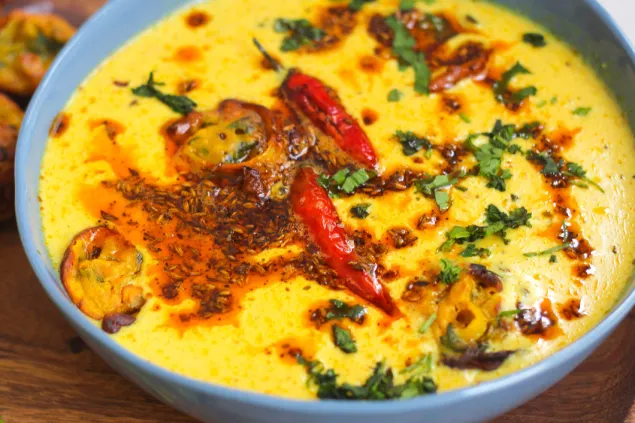
Kadhi is a beloved dish from North India, particularly cherished in Punjabi cuisine. It consists of flavorful onion fritters, known as pakoras, immersed in a tangy spiced yogurt sauce. Commonly referred to as Kadhi Pakora, this dish is a perfect accompaniment to steamed rice, offering a comforting and satisfying meal. Whether you’re a seasoned cook or a novice in the kitchen, this Punjabi Kadhi recipe will guide you through the steps to create this traditional dish at home.
Punjabi Kadhi Recipe Punjabi Kadhi Pakora
Prep Time: 40 minutes
Cook Time: 30 minutes
Total Time: 1 hour 10 minutes
Cuisine: North Indian
Course: Main Course
Diet: Vegetarian
Difficulty Level: Moderate
Ingredients
For the Curd Slurry:
- 1.5 cups sour curd (full fat) or sour yogurt (375 grams)
- 3 cups water (or as required)
- ½ teaspoon red chili powder
- ½ teaspoon turmeric powder
- ½ teaspoon garam masala
- 1 generous pinch of asafoetida (hing)
- 1 to 1.5 teaspoons salt (or to taste)
- 8 tablespoons gram flour (besan) (40 grams)
For the Onion Pakora:
- 1 cup thinly sliced onions (about 150 grams or 2 medium to large onions)
- 1 cup gram flour (besan)
- ½ teaspoon red chili powder
- ½ teaspoon garam masala
- ½ teaspoon carom seeds (ajwain)
- ⅔ to ¾ teaspoon salt (or to taste)
- ¼ cup water (or as required)
- Mustard oil, sunflower oil, or any neutral oil (for shallow frying or deep frying)
For the Kadhi:
- ⅓ cup onions, chopped
- 1 tablespoon chopped ginger
- ¾ to 1 tablespoon chopped garlic
- 8 to 10 fenugreek seeds (methi seeds)
- 2 chopped green chilies (or 1 teaspoon serrano peppers)
- 2 dry red chilies (broken and seeds removed)
- 1 teaspoon cumin seeds
- 1 generous pinch of asafoetida (hing)
- 8 to 10 curry leaves (or 1 sprig of curry leaves)
- 2 tablespoons mustard oil, sunflower oil, or any neutral oil
Instructions
Step 1: Making the Curd Slurry
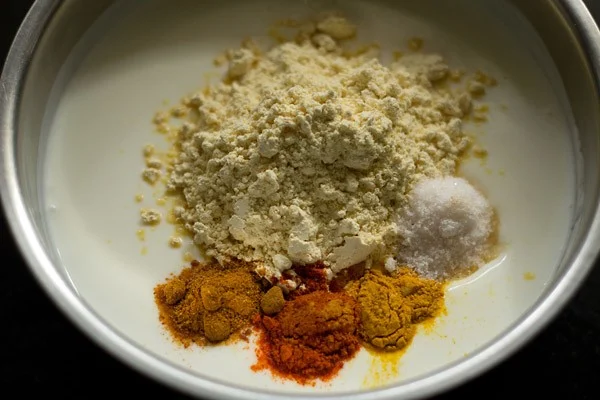
- In a mixing bowl, take the sour curd and whisk it well until smooth.
- Add the gram flour, red chili powder, turmeric powder, garam masala, and salt to the whisked curd.
- Stir well to combine all ingredients.
- Gradually add 3 cups of water while stirring continuously to avoid lumps. If lumps form, use a whisk or spatula to break them down.
- Set the curd slurry aside. If you prefer, a blender can be used, but ensure not to overblend as it might turn into butter.
Step 2: Making the Pakoras
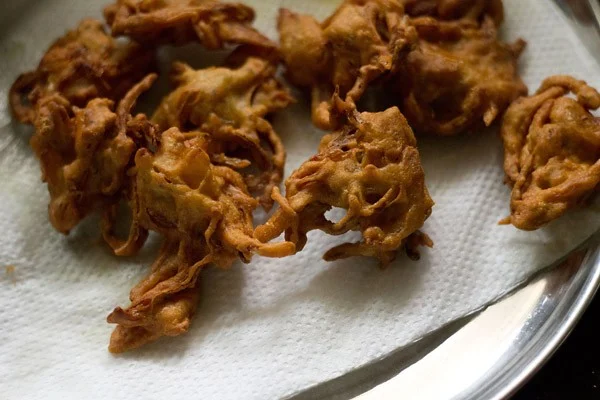
- In a bowl, combine the gram flour, carom seeds, red chili powder, garam masala, and salt.
- Add the thinly sliced onions and mix well. Cover the bowl and let it rest for 30 minutes. This resting time helps the onions release their moisture.
- Depending on the moisture content, add water as necessary to achieve a thick batter (about ¼ cup water is usually sufficient).
- Heat oil in a deep frying pan over medium heat. Once the oil is hot, carefully drop spoonfuls of the pakora batter into the oil.
- Fry until the pakoras are golden brown and crisp, turning them occasionally for even cooking. Remove them and place them on paper towels to absorb excess oil. Repeat with the remaining batter.
Step 3: Making the Kadhi
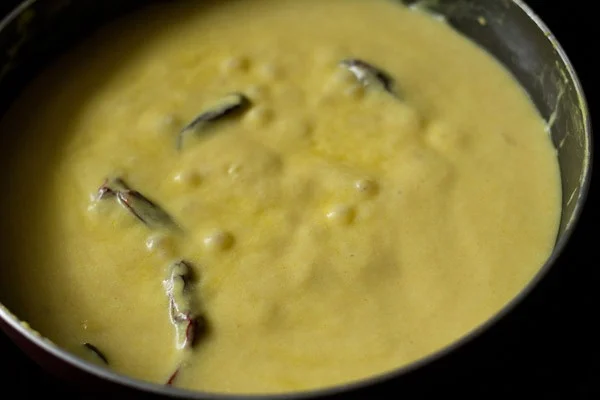
- In another large pot or kadai, heat mustard oil over medium heat. Ensure to use a large pot to prevent overflow while boiling.
- Add cumin seeds, fenugreek seeds, and asafoetida. Allow the cumin seeds to crackle and the fenugreek seeds to change color.
- Add the chopped onions and sauté for 3 minutes until they soften.
- Stir in the chopped ginger, garlic, and green chilies. Cook for another minute.
- Next, add the curry leaves and dry red chilies, sautéing for a minute on low flame.
- Pour in the prepared curd slurry, stirring well. Increase the heat to medium and bring the kadhi to a boil, stirring often to avoid burning at the bottom. This process should take about 14 to 16 minutes.
- After boiling, lower the heat and let it simmer for another 6 to 7 minutes, allowing the kadhi to thicken. If it becomes too thick, you can add hot water to reach the desired consistency.
Step 4: Combining Kadhi and Pakoras
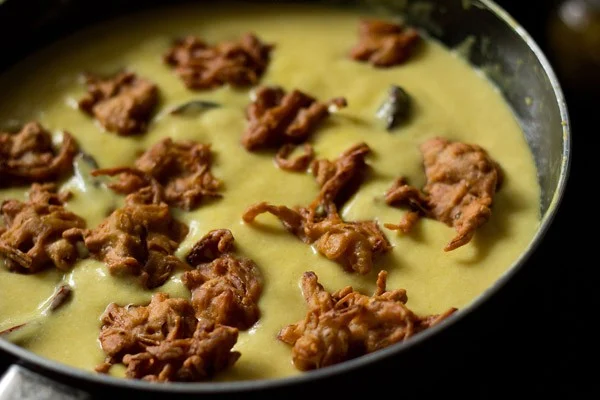
- Gently add the fried onion pakoras to the kadhi and stir carefully.
- Cover the pot and let the pakoras soak in the kadhi for 8 to 10 minutes, absorbing the flavors.
- Finally, sprinkle some garam masala on top before serving.
Serving Suggestions
Punjabi Kadhi Pakora is best served with steaming hot rice or cumin rice. You can also enjoy it with Indian flatbreads like roti or paratha, drizzled with ghee for added richness.
Notes
- Curd: Use full-fat sour curd for the best results. If your curd isn’t sour, let it sit at room temperature for a few hours. Alternatively, you can add a bit of amchur powder or lemon juice during cooking for acidity.
- Oil: Mustard oil adds a distinctive flavor, but any neutral oil will work if unavailable.
- Baking Option: If you prefer a healthier version, consider baking the pakoras. Mix a tablespoon or two of oil into the batter and bake at 180°C (350°F) until crisp.
- Curry Leaves: Essential for authentic flavor, but if you can’t find them, you can skip this ingredient.
- Gram Flour: Use high-quality gram flour for the best texture. Chickpea flour can also be used as a substitute.
- Pakora Texture: For softer pakoras, add more water to the batter and add them to the kadhi just before serving to prevent them from getting too soft.

